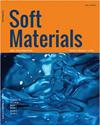Poly-(lactic-co-glycolic acid) /poly-(vinyl alcohol) and cobalt ferrite magnetic nanoparticles as vanillin carriers
IF 1.4
4区 材料科学
Q4 MATERIALS SCIENCE, MULTIDISCIPLINARY
引用次数: 1
Abstract
ABSTRACT Besides being known by food and perfume industries, vanillin has also important pharmacological properties such as anti-inflammatory and antibacterial activities. The use of magnetic nanoparticles as carriers for a vanillin delivery system is a way to explore its benefits in human beings. In this paper, poly(lactic-co-glycolic acid) (PLGA) nanoparticles stabilized by poly(vinyl alcohol) (PVA) and containing magnetic CoFe2O4 and vanillin have been prepared using a double emulsion-solvent evaporation method. The morphology, particle size, structure, and surface properties of the nanoparticles were investigated by transmission electron microscopy, zeta-potential measurements, X-ray diffractometry, Fourier transform infrared spectroscopy, magnetic hysteresis loops, and thermogravimetric analysis. The spherical nanoparticles presented negative charge, with zeta-potential values ranging from −9.15 to −5.64 mV, high thermal stability, superparamagnetic properties, and excellent encapsulation of the vanillin (around 80%). Accordingly, such PLGA/PVA nanoparticles encapsulating vanillin and CoFe2O4 exhibited the desired features to suggest their potential use as drug delivery systems. Highlights PLGA/PVA nanoparticles with CoFe2O4 were synthesized for the targeted delivery of vanillin. The spherical nanoparticles presented negative zeta-potential ranging from −9.15 to −5.64 mV. Encapsulation promoted an increased release rate of vanillin. Analytical validation was used for vanillin quantification.聚(乳酸-羟基乙酸)/聚(乙烯醇)和钴铁氧体磁性纳米颗粒作为香兰素载体
香兰素不仅为食品和香水行业所熟知,还具有抗炎、抗菌等重要药理作用。利用磁性纳米颗粒作为香兰素递送系统的载体是探索其在人体中的益处的一种方式。采用双乳液-溶剂蒸发法制备了以聚乙烯醇(PVA)为稳定剂,含有磁性CoFe2O4和香兰素的聚乳酸-羟基乙酸(PLGA)纳米颗粒。通过透射电子显微镜、zeta电位测量、x射线衍射、傅里叶变换红外光谱、磁滞回线和热重分析研究了纳米颗粒的形貌、粒径、结构和表面性质。球形纳米粒子带负电荷,ζ电位值在−9.15 ~−5.64 mV之间,具有较高的热稳定性和超顺磁性,并具有良好的香兰素包封性(约80%)。因此,这种包封香兰素和CoFe2O4的PLGA/PVA纳米颗粒表现出所需的特征,表明它们有可能作为药物递送系统使用。合成了具有CoFe2O4的PLGA/PVA纳米颗粒,用于靶向递送香兰素。球形纳米粒子呈现负的ζ电位,范围为−9.15 ~−5.64 mV。包封提高了香兰素的释放率。香兰素定量采用分析验证法。
本文章由计算机程序翻译,如有差异,请以英文原文为准。
求助全文
约1分钟内获得全文
求助全文
来源期刊

Soft Materials
工程技术-材料科学:综合
CiteScore
2.90
自引率
0.00%
发文量
21
审稿时长
2.2 months
期刊介绍:
Providing a common forum for all soft matter scientists, Soft Materials covers theory, simulation, and experimental research in this rapidly expanding and interdisciplinary field. As soft materials are often at the heart of modern technologies, soft matter science has implications and applications in many areas ranging from biology to engineering.
Unlike many journals which focus primarily on individual classes of materials or particular applications, Soft Materials draw on all physical, chemical, materials science, and biological aspects of soft matter. Featured topics include polymers, biomacromolecules, colloids, membranes, Langmuir-Blodgett films, liquid crystals, granular matter, soft interfaces, complex fluids, surfactants, gels, nanomaterials, self-organization, supramolecular science, molecular recognition, soft glasses, amphiphiles, foams, and active matter.
Truly international in scope, Soft Materials contains original research, invited reviews, in-depth technical tutorials, and book reviews.
 求助内容:
求助内容: 应助结果提醒方式:
应助结果提醒方式:


